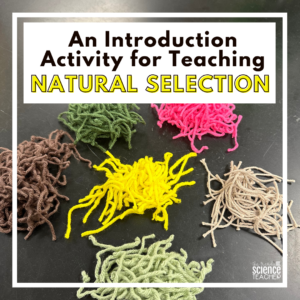
The BEST Lab for Teaching Homeostasis

One of the first lessons that I teach in my Biology course is Characteristics of Living Things. During this lesson, I spend some time focusing on the term homeostasis. In order to provide my students with a visual representation of homeostasis, I always use the Homer-o-stasis lab. My students absolutely love this lab! There are several versions of this lab floating around the internet, but I could never find teacher instructions for preparing the solutions and setting up the lab. This is the main purpose in me writing this blog post- to provide other Bio teachers with images and instructions for setting up The BEST Lab for Teaching Homeostasis.

Note: This post contains affiliate links for Amazon. As an Amazon Associate, I earn from qualifying purchases. By purchasing an item on the Amazon site using these links, I will receive a small commission on your purchase. This commission does not affect the price of your item.
Where can you find this lab?
I found the original student print-out for this lab on Biology with Mrs. McGaffin’s Weebly page. I did modify the original activity to be more of an introductory lab. You can download the student lab sheet that I created HERE. If you want a more advanced lab sheet, her original will do the trick. You can download it here.
What is the goal of this lab?
This lab provides students with a visual representation of the importance of maintaining homeostasis in the human body. In this lab, students are tasked with keeping Homer alive for 5 minutes while maintaining his body temperature, electrolyte concentration, and his fluid levels. Failure to do so will result in the death of Homer.

What supplies do I need?
These are the materials needed for each lab group:
- 1 clear 12 oz. cup
- masking tape
- test tube vial with lid
- 2- 250 mL beakers
- 1 red solo cup of hot water (not boiling- just really warm)
- 1 blue solo cup of cold water
- 1 digital thermometer
- 1 ring stand
- 1 plastic container to catch fluid
- timer/stopwatch
- yellow food coloring (the entire bottle)
- a source of hot & cold water

Teacher Set-Up:
While this lab requires a bit of time to set up, I promise that it will be worth it. Here are the steps that I took to prepare for the lab:
1. Make “Homer”
Using a Sharpie marker, draw Homer Simpson on the front of a clear plastic cup. Poke a small hole at the bottom of the cup so that liquid will trickle out in a small stream. Then, place a piece of masking tape over the hole.

Place the cup so that it sits firmly inside of an iron ring that is secured to a ring stand. Place a plastic bucket/container under the cup.

2. Prepare the “Homer” solution

One of the objectives of this lab is to keep Homer his normal yellow color. You will need to start by mixing yellow food coloring and water until you get a nice yellow color. I mixed a huge batch so that I could use it throughout my 4 Biology classes. Here is the color that you should shoot for.

Pour about 250 mL of the “Homer” solution into a beaker and label the beaker “B.”

3. Create a control sample
Students will need to compare Homer’s color to his normal color. To create a “normal” sample, fill a small test tube with the yellow “Homer” solution and label the test tube “A.”

4. Create an Electrolyte/Sugar Solution
During the lab, Homer’s electrolytes/sugar concentration will drop below normal levels. To provide Homer with a “boost” of energy, students will need to add an electrolyte/sugar solution. To create this solution, you will mix yellow food coloring and water; only this time, you will make it super concentrated. I use an entire bottle of yellow food coloring to make a 2000 mL batch.
This is the color that you are shooting for.

Pour this solution into a 250 mL beaker and label the beaker “C.”

5. Other Preparations
Each lab group will need hot water and cold water. Label a red solo cup “D” and a blue solo cup “E.” You will need to supply your students with hot water (fill red solo cup 3/4 way full) and cold water (fill blue solo cup 3/4 way full).


Place all of the materials at the student lab station, ensuring that you have the correct containers labeled A-E.

Keeping Homer Alive
Students will work together to keep Homer alive for 5 minutes. As time passes, the “Homer” solution will empty out of the “Homer” cup into the waste container. Students must figure out how to maintain his fluid levels while simultaneously keeping his color “normal” and his temperature constant .








This really is The Best Lab for Teaching Homeostasis! It’s always so much fun watching my students balance the chaos of maintaining “Homer-o-stasis.” To check out my entire line-up of Intro to Biology activities, labs, & lessons, click HERE.

Until next time….HAPPY TEACHING!

Share it:
- Read more about: BIOLOGY




